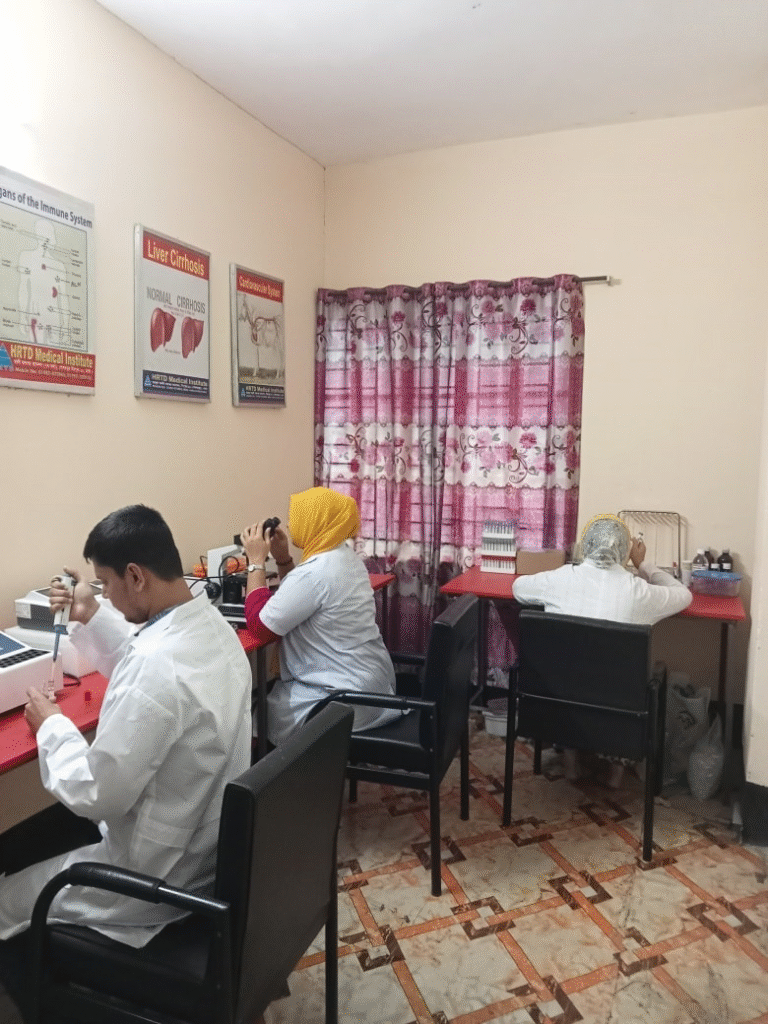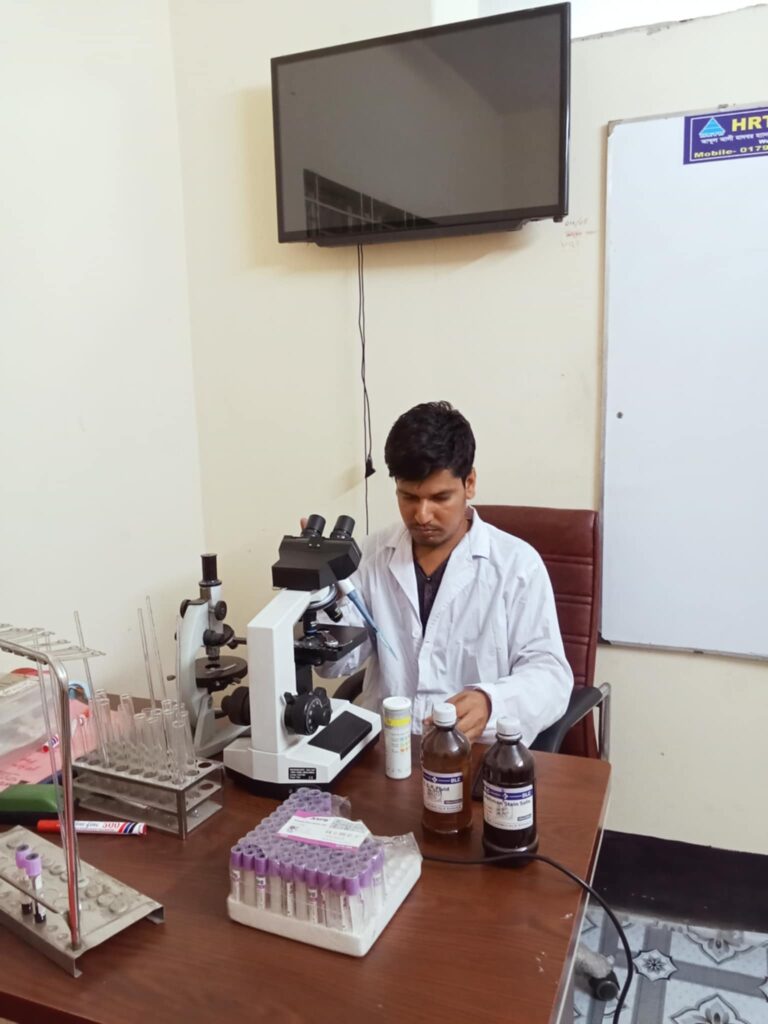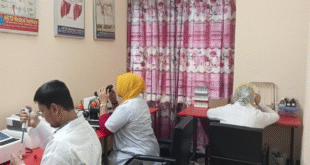Diagnosis of Fatty Liver 01797522136
Introduction
Fatty liver disease has become one of the most common liver conditions in modern society. With the rise of unhealthy diets, sedentary lifestyles, and increasing rates of diabetes and obesity, more and more people are being diagnosed with fatty liver every year. Many individuals do not even realize they have it until they undergo a medical check-up or liver function test.

At HRTD Medical Institute, located at Section-6, Block-Kha, Road-1, Plot-11, Metro Rail Pillar-249, Folpotti Mosque Lane, Mirpur-10, Dhaka-1216, we are dedicated to providing accurate diagnosis, advanced testing, and professional medical guidance to help patients understand and manage fatty liver effectively.
This article will help you understand what fatty liver is, why it occurs, how it can be diagnosed, and what tests are used for confirmation — all explained in simple and clear language for general awareness.
What is Fatty Liver?
Fatty liver, medically known as hepatic steatosis, refers to the accumulation of fat in liver cells. Normally, a healthy liver contains a small amount of fat. However, when fat makes up more than 5–10% of the liver’s weight, it is considered fatty liver disease.
Fatty liver is generally classified into two main types:
- Alcoholic Fatty Liver Disease (AFLD) – caused by excessive alcohol consumption.
- Non-Alcoholic Fatty Liver Disease (NAFLD) – occurs in people who drink little or no alcohol. It is commonly linked to obesity, diabetes, high cholesterol, and poor diet.
NAFLD is the most common type and is often called a “silent disease” because it develops gradually without obvious symptoms.
Why is Early Diagnosis Important?
Many people think fatty liver is harmless. However, if not diagnosed and managed early, it can progress into more severe liver conditions such as:
- Non-Alcoholic Steatohepatitis (NASH): Fat accumulation along with liver inflammation and cell damage.
- Fibrosis: Scar tissue forms in the liver due to continuous inflammation.
- Cirrhosis: Permanent scarring and loss of liver function.
- Liver Cancer (Hepatocellular Carcinoma).
The good news is that fatty liver can often be reversed if detected early through proper diagnosis and lifestyle modification. That’s why timely testing and medical evaluation are extremely important.
Common Causes and Risk Factors
Fatty liver can result from a combination of lifestyle and health-related factors. The major causes include:
- Obesity and Overweight
- Type 2 Diabetes
- High Blood Cholesterol or Triglycerides
- Sedentary Lifestyle
- Unhealthy Diet (High Sugar, Processed Food, Fast Food)
- Alcohol Consumption
- Certain Medications (Steroids, Anti-viral drugs, etc.)
- Genetic Factors
- Rapid Weight Loss or Malnutrition
At HRTD Medical Institute, our specialists always begin with a complete assessment of these risk factors before recommending any diagnostic tests.

Symptoms of Fatty Liver
In most cases, fatty liver has no clear symptoms, especially in the early stage. However, as the condition progresses, some people may experience:
- Persistent tiredness or fatigue
- Discomfort or dull pain in the upper right side of the abdomen
- Loss of appetite
- Unexplained weight loss
- Mild jaundice (yellowing of skin or eyes)
- Swelling in legs or abdomen (in advanced cases)
Since symptoms can be very mild or absent, diagnostic tests are the only reliable way to confirm whether someone has fatty liver.
How is Fatty Liver Diagnosed?
Diagnosing fatty liver involves several steps, including clinical evaluation, laboratory tests, imaging studies, and sometimes biopsy. Below are the major diagnostic approaches used at HRTD Medical Institute.
1. Clinical Evaluation
A healthcare provider starts with:
- Medical history review (alcohol use, medications, family history)
- Physical examination
- Assessment of risk factors like obesity, diabetes, or hypertension
The doctor may also evaluate body mass index (BMI) and check for liver enlargement by gentle abdominal palpation.
2. Blood Tests
Blood tests play a vital role in detecting liver abnormalities. The following are commonly performed at HRTD Medical Institute:
a. Liver Function Tests (LFT)
These tests measure enzymes and proteins that indicate how well the liver is functioning.
- ALT (Alanine Aminotransferase) and AST (Aspartate Aminotransferase): Elevated levels suggest liver inflammation.
- Alkaline Phosphatase (ALP) and Gamma GT (GGT): May also rise in liver disorders.
- Bilirubin: Indicates bile function and liver health.
- Albumin and Total Protein: Help assess liver’s synthetic function.
A mild elevation in ALT and AST is often the first clue toward fatty liver disease.
b. Blood Sugar and Lipid Profile
- Fasting Blood Glucose and HbA1c check for diabetes.
- Cholesterol and Triglyceride levels help identify metabolic syndrome.
c. Viral Hepatitis Screening
To rule out other causes of liver disease, tests for Hepatitis B and C are often recommended.

3. Imaging Studies
Imaging plays a key role in confirming fat deposition in the liver. The most common and reliable imaging methods are:
a. Ultrasound (Sonography)
- Most commonly used and non-invasive.
- Shows a “bright” or “hyperechoic” liver pattern indicating fat accumulation.
- Can detect moderate to severe fatty changes.
b. CT Scan (Computed Tomography)
- Provides more detailed imaging.
- Measures liver density to estimate fat levels.
c. MRI (Magnetic Resonance Imaging)
- The most sensitive method for quantifying liver fat.
- MRI-based techniques can also estimate liver fibrosis.
d. FibroScan (Transient Elastography)
- A specialized test that measures liver stiffness.
- Helps detect fibrosis and cirrhosis in addition to fatty infiltration.
- Available at HRTD Medical Institute for advanced liver evaluation.
4. Liver Biopsy (In Selected Cases)
In rare cases, when imaging and blood tests are inconclusive, a liver biopsy may be done. A small tissue sample is taken from the liver using a fine needle and examined under a microscope.
A biopsy provides the most accurate diagnosis and helps determine:
- The amount of fat in the liver.
- Presence of inflammation or fibrosis.
- Stage of liver disease.
Although biopsy is an invasive procedure, it is sometimes necessary to confirm NASH (Non-Alcoholic Steatohepatitis).
Diagnostic Criteria and Grading
Doctors may classify fatty liver based on imaging or biopsy results into grades or stages:
| Grade | Description |
|---|---|
| Grade 1 (Mild): | Small fat deposits; no liver damage. |
| Grade 2 (Moderate): | Moderate fat buildup; some inflammation. |
| Grade 3 (Severe): | Large fat deposits; possible fibrosis or cirrhosis. |
The grading helps determine the treatment plan and follow-up schedule.
Special Diagnostic Services at HRTD Medical Institute
At HRTD Medical Institute, Mirpur-10, Dhaka, we provide comprehensive diagnostic facilities for fatty liver and other liver-related diseases under the supervision of experienced professionals.
Available Tests
- Liver Function Test (LFT)
- SGOT/AST, SGPT/ALT
- Gamma GT (GGT)
- Lipid Profile
- Blood Sugar & HbA1c
- Ultrasound (Abdomen)
- FibroScan (Liver Stiffness Test)
- Hepatitis B & C Screening
Why Choose HRTD Medical Institute
- Modern laboratory equipment
- Qualified medical technologists
- Accurate and timely reports
- Affordable test packages
- Friendly and supportive staff
- Guidance on diet, exercise, and lifestyle modification
Our mission is to ensure early detection and awareness so that people can take control of their liver health before complications arise.
Interpreting the Test Results
Understanding test results helps patients take preventive steps.
Here’s a simplified overview:
| Test | Normal Range | Interpretation |
|---|---|---|
| ALT (SGPT) | 7–56 U/L | Elevated = possible liver inflammation |
| AST (SGOT) | 10–40 U/L | High = liver or muscle damage |
| GGT | 9–48 U/L | Often elevated in fatty liver or alcohol-related damage |
| Bilirubin | 0.1–1.2 mg/dL | High = impaired liver function |
| Albumin | 3.5–5.0 g/dL | Low = chronic liver disease possible |
Always consult a physician to interpret results properly — self-diagnosis can be misleading.
Prevention and Lifestyle Management
Even though diagnosis is important, prevention is better.
Here are lifestyle changes that can help reverse early fatty liver:
- Healthy Diet: Reduce sugar, fried food, and refined carbs. Eat vegetables, fruits, lean proteins, and whole grains.
- Regular Exercise: At least 30 minutes of walking or moderate activity daily.
- Weight Control: Gradual weight loss (not rapid crash diets).
- Limit Alcohol: Avoid or minimize alcohol intake.
- Control Blood Sugar and Cholesterol: Follow medical advice for diabetes or high lipid levels.
- Stay Hydrated: Drink sufficient water daily.
- Regular Checkups: Get liver function and ultrasound every 6–12 months if you are at risk.
HRTD Medical Institute offers personalized counseling and dietary guidance for patients with fatty liver and related conditions.
When Should You Get Tested?
You should consider getting a fatty liver screening if you have any of the following:
- Obesity or overweight
- Type 2 diabetes or insulin resistance
- High blood pressure or cholesterol
- Family history of liver disease
- History of alcohol consumption
- Unexplained fatigue or abdominal discomfort
- Abnormal liver test results
At HRTD Medical Institute, we encourage everyone above 30 years of age or anyone with risk factors to undergo routine liver screening.
Educational and Awareness Role of HRTD Medical Institute
As a leading healthcare training and diagnostic center in Dhaka, HRTD Medical Institute not only performs tests but also promotes public education on liver health.
Our expert trainers and technologists conduct:
- Awareness seminars on liver disease prevention
- Community health programs
- Medical laboratory training on liver function testing
- Guidance for students on modern diagnostic techniques
Through these activities, we aim to build a healthier and more informed community.
Frequently Asked Questions (FAQ)
1. Can fatty liver be cured?
Yes. If diagnosed early and managed properly through diet and exercise, fatty liver can often be completely reversed.
2. Is fatty liver dangerous?
Mild fatty liver is usually not dangerous, but if ignored, it can progress to cirrhosis or liver cancer.
3. Can I drink alcohol if I have fatty liver?
It is strongly advised to avoid alcohol, as it worsens liver fat and inflammation.
4. How often should I test my liver?
If you are at risk, you should test every 6 to 12 months or as recommended by your doctor.
5. Which test is best to confirm fatty liver?
Ultrasound is the most common screening test. FibroScan and MRI provide more detailed assessment.
6. Can thin people get fatty liver?
Yes. Even normal-weight individuals can have fatty liver due to poor diet, diabetes, or genetics.
7. What should I eat if I have fatty liver?
Eat fresh fruits, vegetables, whole grains, fish, and olive oil. Avoid sugar, fried food, and processed snacks.
Conclusion
Fatty liver disease has become a silent but growing health concern in Bangladesh and around the world. The condition often develops without symptoms, making diagnosis and early intervention crucial.
At HRTD Medical Institute, we emphasize accurate diagnosis, professional care, and patient education. Our modern laboratory and imaging facilities ensure that every patient receives reliable and timely reports, while our doctors and technologists guide patients toward a healthier lifestyle.
If you or someone you know suspects fatty liver or wants to check liver health, visit us today at:
📍 HRTD Medical Institute
Section-6, Block-Kha, Road-1, Plot-11
Metro Rail Pillar-249, Folpotti Mosque Lane
Mirpur-10, Dhaka-1216
📞 Contact: 01797522136 | 01987073965 | 01784572173
Your liver health is in your hands — and at HRTD Medical Institute, we’re here to help you every step of the way.
 Pathology Training Institute in Bangladesh Best Pathology Training Institute in Bangladesh
Pathology Training Institute in Bangladesh Best Pathology Training Institute in Bangladesh



